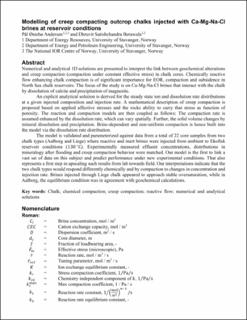| dc.contributor.author | Andersen, Pål Østebø | |
| dc.contributor.author | Berawala, Dhruvit Satishchandra | |
| dc.date.accessioned | 2023-01-12T11:43:57Z | |
| dc.date.available | 2023-01-12T11:43:57Z | |
| dc.date.created | 2019-05-24T21:45:02Z | |
| dc.date.issued | 2019 | |
| dc.identifier.citation | Andersen, P. Ø., & Berawala, D. S. (2019). Modeling of Creep-Compacting Outcrop Chalks Injected with Ca-Mg-Na-Cl Brines at Reservoir Conditions. SPE Journal, 24(06), 2889-2910. | en_US |
| dc.identifier.issn | 1086-055X | |
| dc.identifier.uri | https://hdl.handle.net/11250/3043000 | |
| dc.description.abstract | Numerical and analytical 1D solutions are presented to interpret the link between geochemical alterations and creep compaction (compaction under constant effective stress) in chalk cores. Chemically reactive flow enhancing chalk compaction is of significant importance for enhanced oil recovery (EOR), compaction, and subsidence in North Sea chalk reservoirs. The focus of this study is on Ca-, Mg-, and NaCl brines that interact with the chalk by the dissolution of calcite and the precipitation of magnesite.
An explicit analytical solution is derived for the steady–state ion and dissolution–rate distributions at a given injected composition and injection rate. A mathematical description of creep compaction is proposed on the basis of applied affective stresses and rock ability to carry these stresses as a function of porosity. The reaction and compaction models are then coupled as follows: The compaction rate is assumed, which is enhanced by the dissolution rate, which can vary spatially. Furthermore, the solid volume changes by mineral dissolution and precipitation. Brine–dependent and nonuniform compaction is hence built into the model by means of the dissolution–rate distribution.
The model is validated and parameterized against data from a total of 22 core samples from two chalk types (Åalborg and Liege) where reactive and inert brines were injected from ambient to Ekofisk–reservoir conditions (130°C). Experimentally measured effluent concentrations, distributions in mineralogy after flooding, and creep–compaction behavior were matched. Our model is the first to link a vast set of data on this subject and predict performance under new experimental conditions. This also represents a first step in upscaling such results from the laboratory toward the field. Our interpretations indicate that the two chalk types would respond differently chemically and by compaction to changes in the concentration and injection rate. Brines injected through Liege chalk appeared to approach stable oversaturation, while in Åalborg, the equilibrium condition was in agreement with geochemical calculations. | en_US |
| dc.language.iso | eng | en_US |
| dc.publisher | Society of Petroleum Engineers | en_US |
| dc.title | Modelling of creep compacting outcrop chalks injected with Ca-Mg-Na-Cl brines at reservoir conditions | en_US |
| dc.type | Peer reviewed | en_US |
| dc.type | Journal article | en_US |
| dc.description.version | acceptedVersion | en_US |
| dc.rights.holder | The authors | en_US |
| dc.subject.nsi | VDP::Teknologi: 500 | en_US |
| dc.source.journal | SPE Journal | en_US |
| dc.identifier.doi | 10.2118/192018-PA | |
| dc.identifier.cristin | 1700207 | |
| dc.relation.project | Norges forskningsråd: 230303 | en_US |
| cristin.unitcode | 217,8,11,0 | |
| cristin.unitcode | 217,8,6,0 | |
| cristin.unitname | Institutt for energiressurser | |
| cristin.unitname | Institutt for energi- og petroleumsteknologi | |
| cristin.ispublished | false | |
| cristin.fulltext | postprint | |
| cristin.qualitycode | 2 | |
